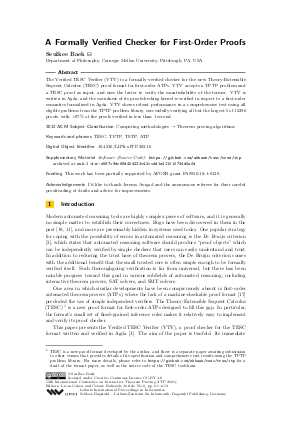LIPIcs.ITP.2021.6.pdf
- Filesize: 0.64 MB
- 13 pages

 Creative Commons Attribution 4.0 International license
Creative Commons Attribution 4.0 International license

The Verified TESC Verifier (VTV) is a formally verified checker for the new Theory-Extensible Sequent Calculus (TESC) proof format for first-order ATPs. VTV accepts a TPTP problem and a TESC proof as input, and uses the latter to verify the unsatisfiability of the former. VTV is written in Agda, and the soundness of its proof-checking kernel is verified in respect to a first-order semantics formalized in Agda. VTV shows robust performance in a comprehensive test using all eligible problems from the TPTP problem library, successfully verifying all but the largest 5 of 12296 proofs, with >97% of the proofs verified in less than 1 second.























Feedback for Dagstuhl Publishing